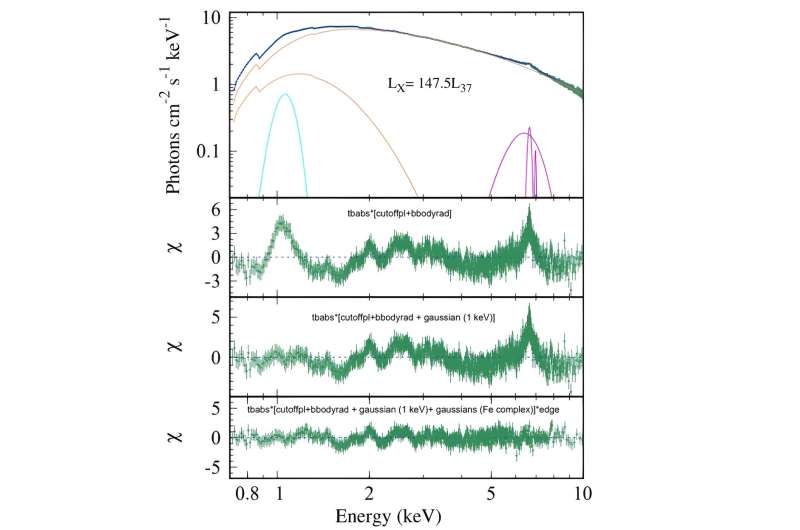February 6, 2024 report
This article has been reviewed according to Science X's editorial process and policies. Editors have highlighted the following attributes while ensuring the content's credibility:
fact-checked
preprint
trusted source
proofread
Astronomers examine the behavior of X-ray pulsar Swift J0243.6+6124

By analyzing the data from the Neutron star Interior Composition Explorer (NICER), astronomers from the Physical Research Laboratory (PRL) in Ahmedabad, India and elsewhere, have performed a detailed X-ray timing and spectral study of an ultraluminous X-ray pulsar designated Swift J0243.6+6124. Results of the study, presented January 26 on the pre-print server arXiv, deliver important insights into the behavior of this pulsar.
Ultra-luminous X-ray sources (ULXs) are point sources in the sky that are so bright in X-rays that each emits more radiation than 1 million suns emit at all wavelengths. Although they are less luminous than active galactic nuclei, they are more consistently luminous than any known stellar process.
Astronomers generally believe that due to their brightness, most ULXs are black holes. However, recent observations have found that some ULXs showcase coherent pulsations. These sources, known as ultra-luminous X-ray pulsars (ULXPs), are neutron stars typically less massive than black holes. The list of known ULPs is still relatively short; thus, studying objects of this class is essential for researchers exploring the universe in X-rays.
Swift J0243.6+6124 was discovered by NASA's Swift spacecraft during its powerful X-ray outburst in 2017–2018. It is considered to be the first Galactic ULX due to its intense X-ray luminosity reaching up to an order of one duodecillion erg/s.
Previous studies of Swift J0243.6+6124 have found that it hosts a neutron star with a pulsation period of 9.8 seconds and a companion (donor) star of spectral type O9.5Ve. The system has a relatively short orbital period of about 28 days.
A team of astronomers led by PRL's Birenda Chhotaray has conducted a long-term study of Swift J0243.6+6124, focusing mainly on its outburst activity between 2017 and 2023. Their timing and spectral analysis allowed them to better understand the behavior of this ULXP during different luminosity phases.
NICER observations revealed a luminosity-dependent break in the power density spectra of Swift J0243.6+6124, suggesting the change in accretion dynamics with mass accretion rate. Moreover, the data indicate quasi-periodic oscillations (QPOs) within a specific luminosity range.
Between June and September 2023, Swift J0243.6+6124 went into an outburst phase during which the neutron star exhibited a spin-up state and variations in its pulse profile. Spectral analysis detected two luminosity-dependent transitions at luminosities of about 75 and 210 undecillion erg/s in continuum parameters. These results point to three distinct accretion modes during the giant 2017–2018 outburst.
The researchers also detected in the spectra of Swift J0243.6+6124 a soft blackbody component with a temperature of 0.08-0.7 keV. It appears that this component underwent a discontinuous transition as the source evolved from a sub-Eddington to a super-Eddington state.
More information: Birendra Chhotaray et al, Long-term study of the first Galactic ultraluminous X-ray source Swift J0243.6+6124 using NICER, arXiv (2024). DOI: 10.48550/arxiv.2401.15058
Journal information: arXiv
© 2024 Science X Network





















